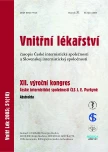Fokální síňová tachykardie
Klinické projevy, místa vzniku a výsledky katetrové ablace
Authors:
M. Fiala 1,2; J. Chovančík 1; P. Heinc 2; R. Neuwirth 1; R. Nevřalová 1; I. Nykl 1; M. Branny 1
Authors‘ workplace:
Kardiocentrum Nemocnice Podlesí, Třinec, přednosta prim MUDr. Marian Branny
1; I. interní klinika Lékařské fakulty UP a FN, Olomouc, přednosta prof. MUDr. Jan Lukl, CSc.
2
Published in:
Vnitř Lék 2005; 51(10): 1070-1078
Category:
Original Contributions
Overview
Focal atrial tachycardia is an infrequent arrhythmia in adult patients.
The purpose of the study is presentation of clinical manifestation, localization of ectopic foci in the atria, and immediate and long-term results of catheter ablation.
Patients and methods:
Intracardiac mapping and catheter a ablation was employed in 50 patients (34 females), aged 44,9 ± 16,8 years, in 53 procedures.
Results:
A total of 50 ectopic foci, 36 in the right atrium or the inter-atrial septum, and 14 in the left atrium, were found and ablated. Noninducibility of the tachycardia at the end of the procedure was immediately achieved in all the patients. In 9 (18 %) patients, a different supraventricular monomorphic tachycardia was present and simultaneously eliminated. Three patients, in whom the target atrial tachycardia recurred, underwent a second ablation, which was successful. During long-term follow-up of 34.9 ± 27.4 months since the last ablation, the original tachycardia recurred in 3 (6 %) patients, nevertheless, clinical course significantly improved in two of these patients. Five patients experienced a different clinically significant atrial tachyarrhythmia (paroxysmal atrial fibrillation resp. inappropriate sinus tachycardia) that was successfully supressed with antiarrhythmic medication. Thus, in long term, original atrial tachycardia is completely eliminated in 47 (94 %) patients without need for antiarrhythmic drugs and 42 (84 %) patients did not have any arrhythmic problem.
Conclusion:
Focal atrial tachycardia manifests with different clinical and electrophysiological properties. Ectopic foci are localized in typical regions in both atria. Catheter ablation can be accomplished safely and with excellent long-term results.
Key words:
focal atrial tachycardia - ectopic foci - catheter ablation
Sources
1. Chen SA, Chiang CE, Yang CJ et al. Sustained atrial tachycardia in adult patients: Electrophysiological characteristics, pharmacological response, possible mechanisms and effects of radiofrequency ablation. Circulation 1994; 90: 1262-1298.
2. Chen SA, Tai CT, Chiang CE et al. Focal atrial tachycardia: Reanalysis of the clinical and electrophysiologic characteristics and prediction of successful radiofrequency ablation. J Cardiovasc Electrophysiol 1998; 9: 355-365.
3. Kall JG, Kopp D, Olshansky B et al. Adenosin-sinsitive atrial tachycardia. Pacing Clin Electrophysiol 1995; 18: 300-306.
4. Kalman JM, Olgin JE, Karch MR et al. „Cristal tachycardias”: Origin of right atrial tachycardias from the crista terminalis identified by intracardiac echocardiography. J Am Coll Cardiol 2001; 38: 1505-1510.
5. Knight BP, Ebinger M, Oral H et al. Diagnostic value of tachycardia features and pacing maneuvers during paroxysmal supraventricular tachycardia. J Am Coll Cardiol 2000; 35: 574-582.
6. Knight BP, Zivin A, Souza J et al. A technique for the rapid diagnosis of atrial tachycardia in the electrophysiology laboratory. J Am Coll Cardiol 1999; 33: 775-781.
7. Man KC, Niebauer M, Daoud E et al. Comparison of atrial-His intervals during tachycardia and atrial pacing with long RP tachycardia. J Cardiovasc Electrophysiol 1995; 6: 700-710.
8. Matsuoka K, Kasai A, Fujii E et al. Electrophysiological features of atrial tachycardia arising from the atriovetnricular annulus. Pacing Clin Electrophysiol 2002; 25: 440-445.
9. Morton JB, Sanders P, Das A et al. Focal atrial tachycardia arising from the tricuspid annulus: Electrophysiologic and electrocardiographic characteristics. J Cardiovasc Electrophysiol 2001; 12: 653-659.
10. Nogami A, Sugut M, Tomita T et al. Novel form of atrial tachycardia originating at the atrioventricular annulus. Pacing Clin Electrophysiol 1998; 21: 2691-2694.
11. Saoudi N, Cosio F, Waldo A et al. Classification of atrial flutter and regular atrial tachycardia according to electrophysiologic mechanism and anatomic bases: A statement form a joint expert group from the Working Group of Arrhythmias of the European Society of Cardiology and the North American Society of Pacing and Electrophysiology. J Cardiovasc Electrophysiol 2001; 12: 852-866.
12. Steinbeck G, Hoffman E “True” atrial tachycardia. Eur Heart J 1998; 19(Suppl E): 10-2, E49-9, E10-19.
13. Tritto M, Zardini M, De Ponti R et al. Iterative atrial tachycardia originating from the coronary sinus musculature. J Cardiovasc Electrophysiol 2001; 12: 1187-1189.
14. Wren C. Incessant tachycardias. Eur Heart J 1998; 19(Suppl E): E32-36, E54-59.
Labels
Diabetology Endocrinology Internal medicineArticle was published in
Internal Medicine

2005 Issue 10
Most read in this issue
-
Fokální síňová tachykardie
Klinické projevy, místa vzniku a výsledky katetrové ablace - Comparison of catheterisation and surgical treatment of ostium secundum type atrial septal defect in adult patients
- Prosthetic Mitral Valve Endocarditis
- Prothrombotic status as part of metabolic syndrome
